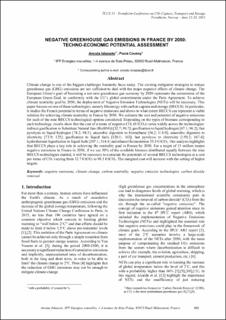| dc.contributor.author | Isbasoiu, Ancuta | |
| dc.contributor.author | Coussy, Paula | |
| dc.date.accessioned | 2021-09-28T07:48:19Z | |
| dc.date.available | 2021-09-28T07:48:19Z | |
| dc.date.issued | 2021 | |
| dc.identifier.isbn | 978-82-536-1714-5 | |
| dc.identifier.issn | 2387-4295 | |
| dc.identifier.uri | https://hdl.handle.net/11250/2783934 | |
| dc.description.abstract | Climate change is one of the biggest challenges humanity faces today. The existing mitigation strategies to reduce greenhouse gas (GHG) emissions are not sufficient to deal with the major negative effects of climate change. The European Union’s goal of becoming a net-zero greenhouse gas economy by 2050 represents the cornerstone of the European Green Deal, in conformity with the EU’s global commitments under the Paris Agreement. To achieve climate neutrality goal by 2050, the deployment of Negative Emission Technologies (NETs) will be necessary. This paper focuses on one of these technologies, namely Bioenergy with carbon capture and storage (BECCS). In particular, it studies the French potential in terms of negative emissions and shows to what extent BECCS can represent a viable solution for achieving climate neutrality in France by 2050. We estimate the cost and potential of negative emissions for each of the nine BECCS technological options considered. Depending on the types of biomass corresponding to each technology, results show that the cost of a tonne of negative CO2 (€/tCO2) varies widely across the technologies: indirect gasification to Substitute Natural Gas (BioSNG) [32.7; 98.7]; gasification to liquid hydrogen [67.1; 96.2]; fast pyrolysis to liquid hydrogen [78.2; 98.5]; anaerobic digestion to biomethane [54,2; 118.9]; anaerobic digestion to electricity [73.9; 125]; gasification to liquid fuels [120.1; 163]; fast pyrolysis to electricity [150.2; 167.4]; hydrothermal liquefaction to liquid fuels [207.1; 314.4] and ethanol fermentation 53.3 €/tCO2. Our analysis highlights that BECCS plays a key role in achieving the neutrality goal in France by 2050. For a target of 15 million tonnes negative emissions in France in 2050, if we use 50% of the available biomass distributed equally between the nine BECCS technologies studied, it will be necessary to cumulate the potentials of several BECCS technologies at a cost per tonne of CO2 varying from 32.7 €/tCO2 to 98.5 €/tCO2. The marginal cost will increase with the setting of higher targets. | en_US |
| dc.language.iso | eng | en_US |
| dc.publisher | SINTEF Academic Press | en_US |
| dc.relation.ispartof | TCCS–11. CO2 Capture, Transport and Storage. Trondheim 22nd–23rd June 2021.
Short Papers from the 11th International Trondheim CCS Conference | |
| dc.relation.ispartofseries | SINTEF Proceedings;7 | |
| dc.rights | CC BY 4.0 | * |
| dc.rights.uri | https://creativecommons.org/licenses/by/4.0/ | * |
| dc.subject | Negative emissions | en_US |
| dc.subject | Climate change | en_US |
| dc.subject | Carbon neutrality | en_US |
| dc.subject | Negative emission technologies | en_US |
| dc.subject | Carbon dioxide removal | en_US |
| dc.title | Negative Greenhouse Gas Emissions in France By 2050: Techno-Economic Potential Assessment | en_US |
| dc.type | Chapter | en_US |
| dc.description.version | publishedVersion | en_US |
| dc.rights.holder | © 2021 The Authors. Published by SINTEF Academic Press. | en_US |
| dc.subject.nsi | VDP::Teknologi: 500 | en_US |

